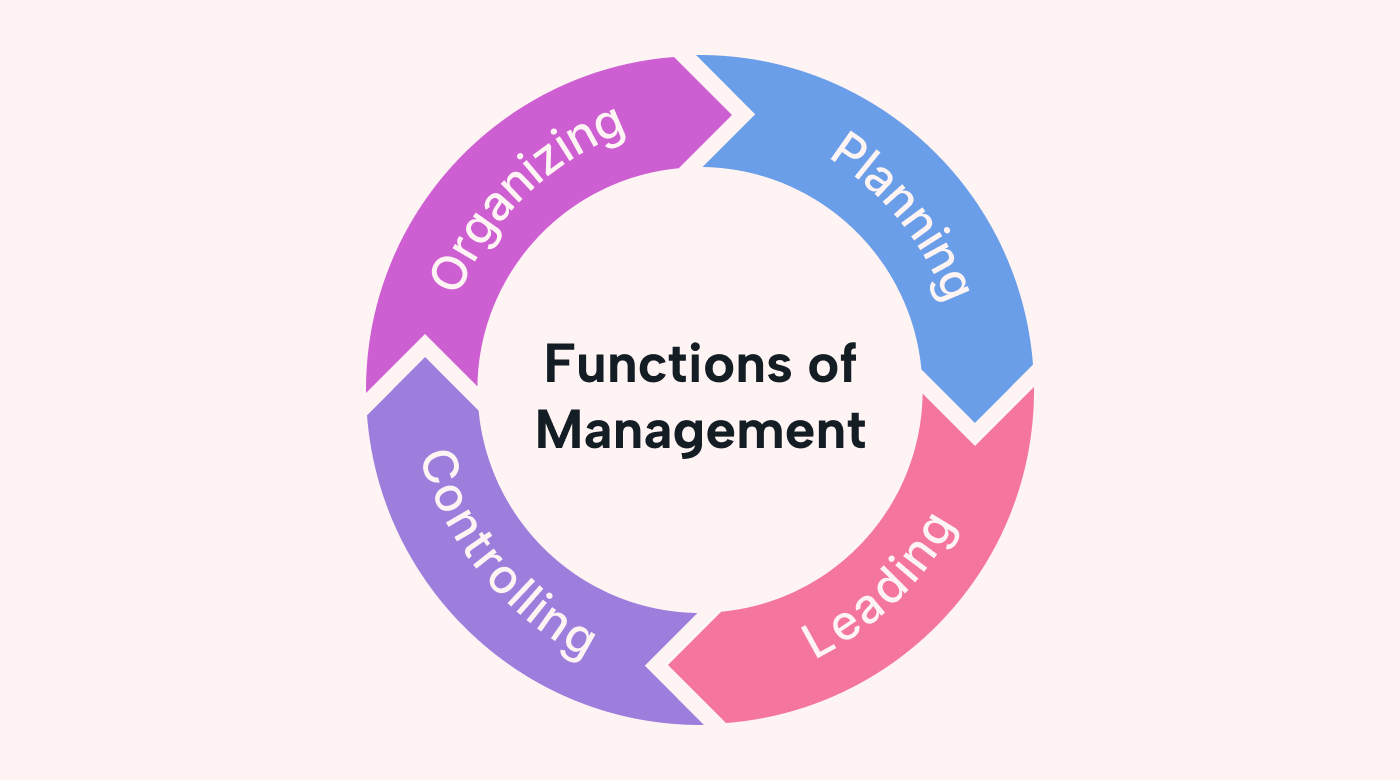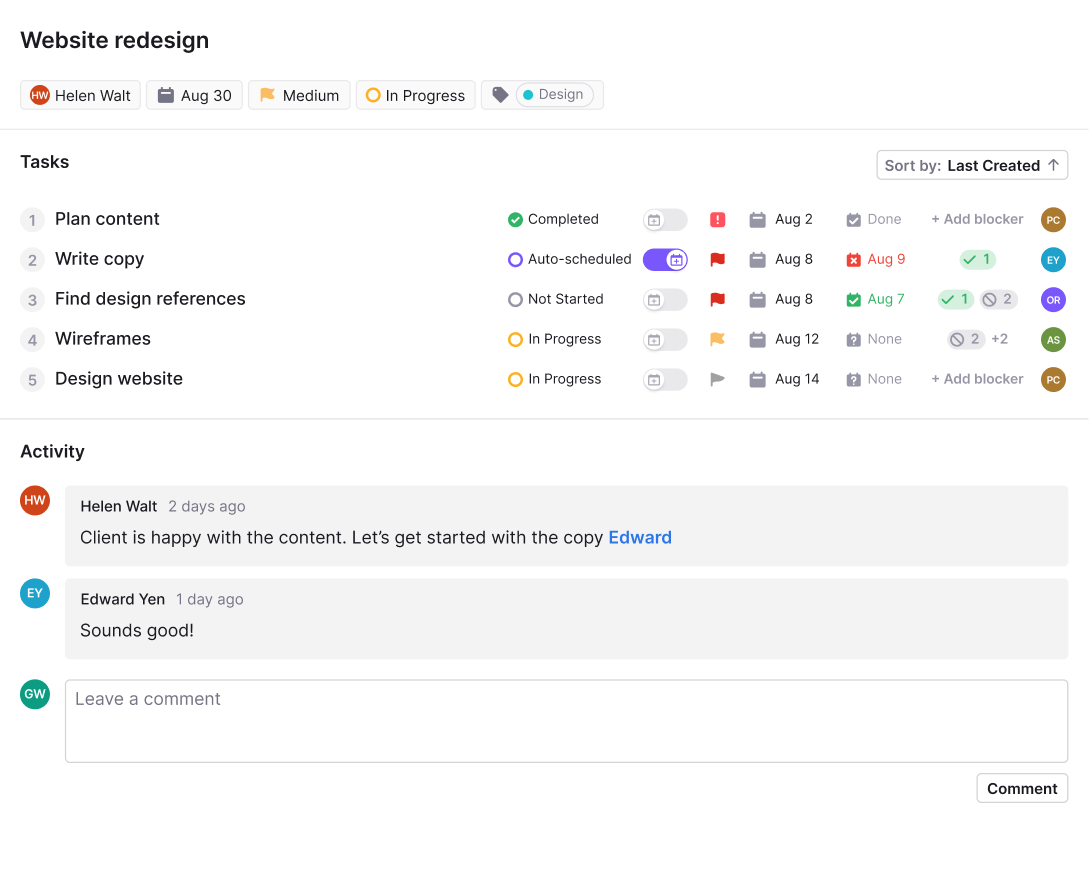In today’s dynamic and competitive business landscape, effective management is crucial for achieving growth, optimizing performance, and staying ahead of the curve. That’s where the four functions of management come into play.
Although originally identified in the early 20th century by visionary Henri Fayol, this time-tested framework is still applicable to business leaders and managers today. It provides a roadmap through which to navigate the complexities of the modern business world.
In this article, we’ll explain what each of the four functions of management entails and offer some practical examples. We’ll also show you how Motion can help you apply these management functions in your team.
The four functions of management, with examples
The four functions of management — planning, organizing, leading, and controlling — serve as the pillars that allow organizations to meet their goals. These functions are interdependent and equally important for ensuring the smooth operation of any business.
Planning
Planning is the foundational function of management. It involves setting objectives and determining the best ways to achieve them. Planning by management is crucial, as it sets the direction for the business and helps prepare for potential challenges and uncertainties.
 |
Common steps in the planning process include the following:
- Setting objectives
- Analyzing the situation
- Developing strategies
- Evaluating your options
- Implementing the plan
- Monitoring and reviewing
Imagine you are the manager of a marketing department and responsible for planning the launch of a new product. You would plan by setting clear objectives, conducting market research, and identifying target demographics. You would also develop a pricing strategy, create a marketing campaign timeline, and allocate resources effectively. Planning ensures that the product launch is strategically organized, aligning with customer needs and market opportunities.
Organizing
The organizing function involves arranging and structuring work to accomplish organizational goals. In other words, this function of management is about setting things up so that the business runs efficiently.
 |
Proper organization is crucial for several reasons, including the following:
- Resource efficiency: Organizing ensures that vital resources, such as time, money, and equipment, are allocated optimally. This not only prevents wastage but also maximizes the return on investment. With the right organizational structure, businesses can avoid redundancy, and employees can avoid duplicating their efforts.
- Clear roles: A well-organized system means that every member of the team knows exactly what they’re responsible for. This reduces confusion and the chances that tasks will fall through the cracks. It also promotes accountability and helps team members focus on their specific roles without overstepping their boundaries or leaving tasks undone.
- Defined authority: Knowing who is in charge of what is more than just a hierarchy — it’s about streamlining decision-making processes. By defining authority, organizations ensure that decisions are made at the right levels without unnecessary bureaucracy or delay. This clear delineation of roles and reporting lines fosters an environment of respect and understanding, leading to quicker resolutions and more efficient operations.
Let’s continue with the example of the marketing department manager. Once the objectives and plans for the product launch are set, organization comes into play. This step involves assigning roles and responsibilities to team members, creating a marketing campaign team, and establishing the budget and resources needed.
You would organize regular meetings, develop a project plan, and ensure effective communication channels are in place for team collaboration.
Leading
In management, leading involves guiding and motivating a team toward a common goal. Leaders ensure that all team members understand their roles and how best to execute them. With the right leadership and inspiration, everyone works together efficiently to achieve the company’s objectives.
 |
Effective leaders possess the following qualities:
- Emotional intelligence
- Good communication skills
- Confidence
- The ability to inspire
- Task delegation skills
A good example of successful leadership is Microsoft’s CEO Satya Nadella, who focuses on a “growth mindset.” His emphasis on cooperation and empathy has made significant improvements in the company’s performance and employee satisfaction.
In our marketing manager example, you would inspire and motivate your marketing team by providing guidance and direction and clearly communicating the company’s vision and goals for the marketing campaign.
Effective leadership also involves supporting team members, encouraging innovation, and resolving any conflicts that arise during the product launch process.
Controlling
The term “controlling” often has negative connotations. In the world of management, it can sound as though managers are trying to dominate or micromanage their employees.
However, the controlling function of management is about monitoring progress toward goal achievement and taking corrective action when necessary. Taking a certain level of control helps managers ensure proper resource allocation, maintain quality control, and keep the team on track toward its objectives.
 |
Toyota’s production system, known as “Just-in-Time” production, is an excellent example of successful controlling. This system emphasizes efficiency by controlling inventory and reducing waste, which leads to improved product quality and reduced costs.
Controlling plays a vital role in the success of a product launch. As a manager, you would establish performance metrics to measure the progress of the marketing campaign. You could use sales numbers or website traffic, for instance, to monitor and compare the actual results against the set goals.
If there is a big difference between them, you would take corrective action. For instance, if actual sales are lower than what was forecasted, you could adjust the marketing strategy or reallocate resources to improve performance.
How the four management functions work together
The four functions of management don’t operate in isolation. Instead, they are interrelated and mutually dependent. They work together in a cyclical nature, with each one influencing and supporting the others.
For example, the feedback from controlling can lead to new planning. Effective organization depends on a clear plan, while effective leadership depends on a well-organized team. Finally, effective control measures rely on clear leadership and direction.
 |
If any one of these functions is weak or not performed well, the entire management process can suffer. For example, without proper planning, organization becomes chaotic. Without effective leadership, even the best plans might not be correctly executed. And without control, managers won’t know if they’re on track or need to adjust their strategies.
Successfully apply the four functions of management with Motion
Getting the four functions of management right is no small feat. But the challenge is more manageable with the right tool in hand.
Motion is the ultimate ally for successful managers, saving them time, providing clarity, and helping to prevent them from feeling overwhelmed. Our intuitive platform enhances every management function, promoting streamlined operations and decisive leadership.
Here’s how Motion helps with each of the four management functions:
Planning
Whether you’re a visual person who loves the clarity a Kanban board offers or thrive on using lists, Motion’s got you covered. You can lay out tasks, structure your day, and even sketch out an entire project timeline.
 |
But the Motion Task Manager takes task management to the next level, not only organizing your tasks but also scheduling and prioritizing them for on-time completion. No more disjointed tools or overwhelming to-do lists — just enhanced productivity!
Organizing
Forget scattered notes and isolated data. With Motion, everything you need to manage a project is in one central hub. The platform fosters team collaboration, ensuring everyone’s on the same page.
 |
And with its resource allocation and task assignment features, you can ensure each team member has a clear direction.
Leading
Great leadership thrives on information. Motion provides managers with a clear window into team schedules and task updates, ensuring they have all the intel they need to guide their troops effectively. Then, armed with this knowledge, they can make swift and informed decisions.
 |
Controlling
Whether you’re heading up a sales team or a group of IT specialists, staying on track is paramount. Motion offers valuable insights into how individuals and teams spend their hours. By monitoring progress and recognizing trends, management can adapt and maintain a firm grip on the team’s workload, ensuring every challenge is met head-on.
 |
Embrace a world where efficiency meets simplicity with Motion, and let every management challenge become a walk in the park.
Experience the difference first-hand and sign up today for a free 7-day trial.





